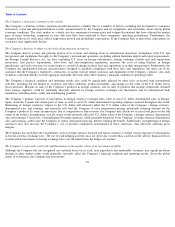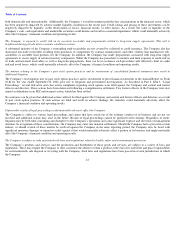Apple 2009 Annual Report Download - page 26
Download and view the complete annual report
Please find page 26 of the 2009 Apple annual report below. You can navigate through the pages in the report by either clicking on the pages listed below, or by using the keyword search tool below to find specific information within the annual report.
Table of Contents
both domestically and internationally. Additionally, the Company’
s overall investment portfolio has concentrations in the financial sector, which
has been negatively impacted by adverse market liquidity conditions in the recent past. Credit ratings and pricing of these investments can be
negatively impacted by liquidity, credit deterioration or losses, financial results, or other factors. As a result, the value or liquidity of the
Company’
s cash, cash equivalents and marketable securities could decline and result in a material impairment, which could materially adversely
affect the Company’s financial condition and operating results.
The Company is exposed to credit risk on its accounts receivable and prepayments related to long-
term supply agreements. This risk is
heightened during periods when economic conditions worsen.
A substantial majority of the Company’
s outstanding trade receivables are not covered by collateral or credit insurance. The Company also has
unsecured non-trade receivables resulting from purchases of components by contract manufacturers and other vendors that manufacture sub-
assemblies or assemble final products for the Company. In addition, the Company has made prepayments associated with long-
term supply
agreements to secure supply of certain inventory components. While the Company has procedures to monitor and limit exposure to credit risk on
its trade and non-trade receivables as well as long-
term prepayments, there can be no assurance such procedures will effectively limit its credit
risk and avoid losses, which could materially adversely affect the Company’s financial condition and operating results.
The matters relating to the Company’
s past stock option practices and its restatement of consolidated financial statements may result in
additional litigation.
The Company’
s investigation into its past stock option practices and its restatement of prior financial statements in the Annual Report on Form
10-K for the year ended September 30, 2006 gave rise to litigation and government investigations. As described in Part I, Item 3, “
Legal
Proceedings,”
several derivative and class action complaints regarding stock options were filed against the Company and current and former
officers and directors. These actions have been dismissed following a comprehensive settlement. Two former officers of the Company were also
named as defendants in an SEC enforcement action, which has been settled.
No assurance can be given that additional actions will not be filed against the Company and current and former officers and directors as a result
of past stock option practices. If such actions are filed and result in adverse findings, the remedies could materially adversely affect the
Company’s financial condition and operating results.
Unfavorable results of legal proceedings could materially adversely affect the Company.
The Company is subject to various legal proceedings and claims that have arisen out of the ordinary conduct of its business and are not yet
resolved and additional claims may arise in the future. Results of legal proceedings cannot be predicted with certainty. Regardless of merit,
litigation may be both time-consuming and disruptive to the Company’
s operations and cause significant expense and diversion of management
attention. In recognition of these considerations, the Company may enter into material settlements. Should the Company fail to prevail in certain
matters, or should several of these matters be resolved against the Company in the same reporting period, the Company may be faced with
significant monetary damages or injunctive relief against it that would materially adversely affect a portion of its business and might materially
affect the Company’s financial condition and operating results.
The Company is subject to risks associated with laws and regulations related to health, safety and environmental protection.
The Company’
s products and services, and the production and distribution of those goods and services, are subject to a variety of laws and
regulations. These may require the Company to offer customers the ability to return a product at the end of its useful life and place responsibility
for environmentally safe disposal or recycling with the Company. Such laws and regulations have been passed in several jurisdictions in which
the Company
23
























